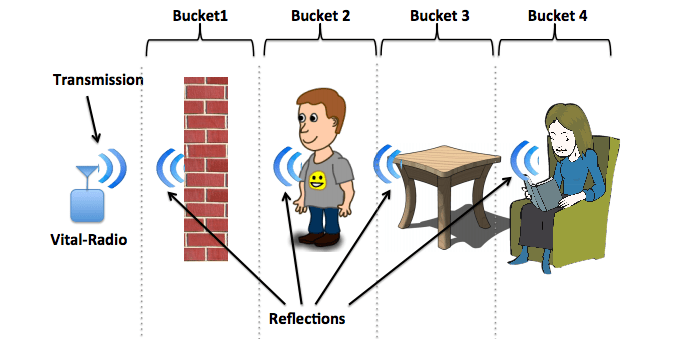The business of tracking your health with smartwatches or fitness trackers is oppressively hardware-heavy — all those wires, charging docks, and batteries. But that’s poised to change. Soon, it might be the space around you that do the monitoring.
For the past few years, we’ve been sold a vision of the future based on wearable computing. Your watch will read your heartbeat! Your necklace will keep track of your breathing! Your pants will monitor your glute strength!
But that’s quickly starting to feel pretty dated. Instead, it seems likely that less invasive systems will take over and make the maintenance-heavy bangles and bands of today seem like cumbersome technologies. Tech that merely served as a bridge to the real thing.
Walls That Watch
One team at MIT is already building such a system.
In a paper presented at the the CHI human computer interaction conference last week, a group of researchers led by Fadel Adib presented a system that makes health monitoring completely passive. It’s called Vital-Radio, and it uses a low-power wireless signal to accurately track the heart rate and breathing patterns of up to three people within roughly 26 feet of the source — even if they’re in another room.

The premise is simple: Since wireless signals travel at the speed of light, a Wi-Fi hub that sends a signal out into a room can measure the time it takes to hit an object or body and “reflect” back. That micro-measurement translates into a very accurate measure of distance. When a person breathes, their ribcage moves significantly — enough that the distance will change, and be picked up by the hub.
The biggest problem with this idea, in the past, was that it’s really hard to separate a person’s reflection from everything else that’s going on in a space — whether we’re talking the signals of a phone or computer, or another person, or other forms of movement. But the team at MIT has figured out a way to “localise” a person’s reflection by zooming in on them.

How could they test the accuracy of the system? Well, they strapped FDA-approved monitoring devices onto more than a dozen subjects and compared the data from each. Their wireless system was 99.3 per cent accurate for breathing and 98.5 accurate for heart rate — pretty damn close for a system that’s still in development. The accuracy hovers around those numbers even when the person was as much as 26 feet away. Another huge plus: It can monitor up to three people in a single room. Without confusing them for one another.
Imagine getting ready to work out without a piece of electronics strapped to your rib cage or wrist — instead, the very walls around you transmit your heartrate to your phone. Or, as Adib’s team suggests, imagine knowing your elderly family members are stable during the night without elaborate medical monitoring devices:
They may use this information to enhance our health-awareness, answering questions like “Do my breathing and heart rates reflect a healthy lifestyle?” They may also help address some of our concerns by answering questions like “Does my child breathe normally during sleep?” or “Does my elderly parent experience irregular heartbeats?”
Smart Is Dumb
The “smart” trope — from smart homes to smart clothing — has been over-used to the point of complete exhaustion. Cameras! Jewellery! Lightbulbs! Clothing! Air conditioners! Shelves! You need to replace every object in your home so that they can “talk” to each other. What are they chatting about? It’s unclear! Something involving making your life easier by ordering more toilet paper for you, probably.
The idea that slapping a computer chip in any random object makes it “smart” even has its own parody Tumblr account, whose description says it all: “It was just a dumb thing. Then we put a chip in it. Now it’s a smart thing.” And there’s one very, very dumb aspect of the smart home that never seems to get mentioned: the massive proliferation of e-waste that comes when we try to fill our lives with hundreds of new, regularly-replaceable electronic devices.

Systems like Vital-Radio are a glimpse at how things could be different. A future where personal computing isn’t wearable, but spatial — it takes advantage of the existing infrastructure of a building, like your Wi-Fi router. One where the “smart” functionality is actually built into existing systems, rather than adding disposable chips.
It’s a little hard to see the consumer electronics market copping to that idea of what technology should become. After all, the entire personal electronics industry is founded on an ever-evolving set of devices that must be replaced every few years by the owner. For now, we’ll probably just bolt our sensors into the drywall or strap them to our wrists. But one day soon, architects won’t just design physical architecture — they will design network architecture, too.
Picture: José Manuel Ríos Valiente/Flickr
